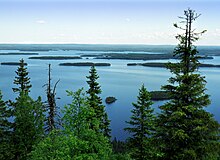North Karelia is in the Finnish Lakeland.
Cities
[edit]Municipalities
[edit]Other destinations
[edit]- 11 Koli National Park — When Finland was building its national identity in the late 19th and early 20th century, Koli inspired many painters and composers, e.g. Eero Järnefelt and Jean Sibelius. Koli became the probably best known national scenery of Finland. It lies on the western shore of Lake Pielinen in the municipalities of Eno, Lieksa and Kontiolahti, and covers 3,000 hectares.
Understand
[edit]The landscape of North Karelia is characterized by forests and numerous lakes, including the national landscapes of Koli National Park. In addition to its beautiful scenery, the region has a rich cultural heritage.
The economy of North Karelia is largely based on forestry and wood processing. There is also a growing technology sector.
While Finnish Karelia is originally part of the same cultural sphere as its namesake across the border, the Finnish part has long been part of first the Swedish realm, then Finland, and thus also has a Western, Lutheran heritage. The Karelian heritage can still be seen in many aspects of the local culture.
Get in
[edit] |
Visa restrictions:
In response to Russia's war in Ukraine, Russian tourists are banned from entering Finland.
|
| (Information last updated Jan 2023) |
North Karelia is surprisingly far away from southern Finland, and for instance a drive from Helsinki to Joensuu will take about six hours – almost as long as up to Oulu.
The main roads, anticlockwise from the north, lead in from Kuhmo (road 75), Kajaani (6), Iisalmi (87), Kuopio (9, 75), Varkaus (23), Savonlinna (71) and Imatra (6). From Helsinki, use road 4 (to Jyväskylä, then road 9 to Kuopio), 5, 6 or 7.
The Blue Highway leads through the region by road 9, continuing across the Niirala/Värtsilä border crossing to Sortavala and Petrozavodsk. For other border crossings you have to come via Kuhmo (across from Kostomuksha) or Imatra (from Vyborg). From Saint Petersburg, choose between Nuijamaa (Lappeenranta), Imatra and Niirala.
By plane
[edit]You can fly directly to Joensuu from Helsinki; 1 Joensuu Airport (JOE IATA) is located 11 kilometers northwest of the city centre. Also you can fly to Helsinki (HEL IATA) and continue by bus or train. Lappeenranta (LPP IATA) has some international flights, most of them operated by Ryanair.
By train
[edit]There are two long distance railroads terminating in Joensuu; one from Helsinki to Lappeenranta and along the border up to Joensuu and another going west–east through the country, via Jyväskylä and Pieksämäki. If you are going to Lieksa or Nurmes you can continue by local train from Joensuu. See VR.
By bus
[edit]There are coach connections from cities and towns in other parts of Eastern Finland, most notably from Kuopio and Lappeenranta, as well as coaches connecting Helsinki with Joensuu, see Matkahuolto.
Get around
[edit]The trains are useful on some routes, see above. From Joensuu there are connections towards Nurmes, Kitee and Heinävesi.
Coaches have a reasonably dense network of services. See Matkahuolto. The governmental ELY-keskus[dead link] has schedules for some regional traffic (here: Waltti).
By taxi
[edit]- Taksi Itä-Suomi offers taxi service in all of the region.
- Smartphone apps (as of 2020): Valopilkku, 02 Taksi, Menevä
See
[edit]
- Visit the WW2 bunker museum near Joensuu.
- See the largest wooden Orthodox church of Finland in Ilomantsi.
- Explore traditional Karelian culture in Joensuu, Lieksa and Nurmes.
- Visit the mine museum in Outokumpu.
Do
[edit]
- Cross Lake Pielinen onboard a ship.
- Sample traditional food such as karjalanpiirakka (Karelian pie) and karjalanpaisti (Karelian stew)
Festivals
[edit]Eat
[edit]Drink
[edit]Stay safe
[edit]North Karelia region is a safe place.


